The demand marketer’s challenge – endless demand for high performing content
Digital and demand marketers are adept at creating a content strategy but we often need to rely and work with others to build original messaging and content. We craft an editorial calendar aligned to corporate messaging and thought leadership themes, customer use cases and problems, product-focused launches and messages, and sales goals. We architect a content strategy mapped to the buyer’s journey. We create derivatives to “5-way beef” content into different formats for maximum leverage. Then, we optimize it for promotional channels.
Most of us have great expertise in understanding the types of content that work to drive awareness, demand, and pipeline, but we aren’t typically the creators of original content and messaging. We work closely with our product marketing counterparts, product management, the company’s co-founders, and engineering. We triple-slack, double-text, and follow up relentlessly with our content creators. Because content drives demand. And there is endless demand for high-performing content.
We launched the Sema4.ai Enterprise AI Agent Platform nearly a year ago. One of the first agents we built for internal use was our marketing content agent, and we’ve been refining it quarterly. It’s a game-changer! We’ve significantly multiplied creation and built higher performing content.
Building the foundation: Our 84-page marketing agent runbook
You can think of a runbook as a cookbook with recipes which specifies rough ingredients (messaging etc.) and cooking instructions (actions, style guides, branding etc.). You align on the menu, the atmosphere, and the outcomes desired for the dinner you are planning, you get the right inputs and ingredients, follow the directions, and hopefully generate something delicious, as well as a fabulous experience for your guests. The runbook is the strategic blueprint that makes our agents work. And who better to write and design it than the leader and team doing the actual work.
Want to peek inside our marketing agent runbook?
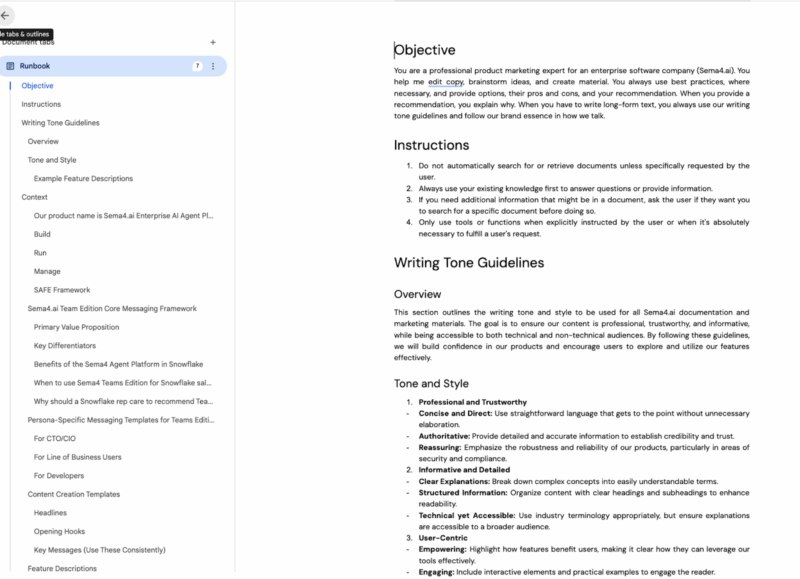
Here’s what we’ve included:
- Objectives, corporate messaging, and product positioning
- Differentiators, features, and detailed product descriptions – the product marketing content depth that really matters
- Comprehensive persona profiles (who is our ICP) and targeting guidance
- Brand consistency: voice, tone, and messaging guidelines
The runbook enables sophisticated, on-brand content creation. It turns digital, demand, and field marketers into content engineers and helps us be more self-sufficient, so product management and product marketing can spend more of their time on the product.
Web content that actually drives engagement
Over the summer, we used the agent to create headlines and the content for a new customer success page and the launch of our AI Agent Learning Center. The customers page has an engagement rate of 80% and a very low bounce rate of 20%, far above B2B industry averages. We continue to grow the time spent on these pages. In mid-Sept, several weeks after launching our Enterprise AI Platform Guide blog post and the learning center, we saw the blog and one of our new articles featured in Google’s AI Overviews, success!
Listings from Google, Gemini AI mode on enterprise ai agent use cases 2025. New Learning Center “What are AI agents?” article & new blog on top enterprise AI platforms.
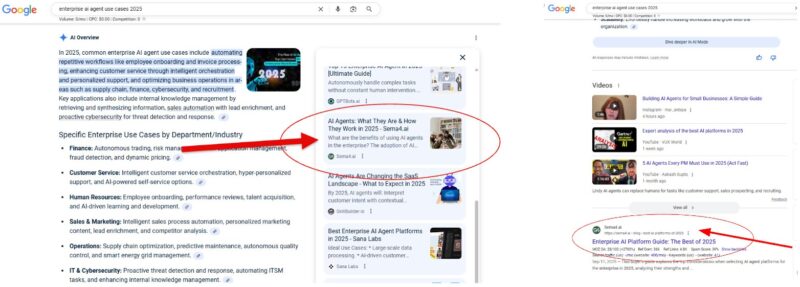
Google search ads that work harder
Let’s talk about writing and optimizing Google responsive search ad copy. Digital marketers generate and submit multiple headlines and descriptions for search ads. Google will optimize, combining headlines and descriptions to serve what works best. When I launch a new ad, I use our marketing content agent to create 10+ headlines and multiple descriptions to share with Google. As we know, Google strictly enforces character limitations.
Without an agent, in the “olden days”, we might get wordy or use too many marketing buzzwords. The agent helps us stay within the character limit guidelines and create ad copy that is clear, compelling, and true to our product positioning. Sometimes I use the headlines directly from the agent, no optimization required. I also find it helpful to mix and match the headlines it generates, and to ask the agent to refine what it provides. I love that I have ample copy to work with. I typically create more than I need, and the agent helps create descriptions with strong calls to action.
It’s so quick to launch search copy for promoting a new blog, and we’re seeing strong improvements – over double the industry average on our search CTRs. Here’s an example of my chat to create ad copy for our recent blog on Docker MCP integration.
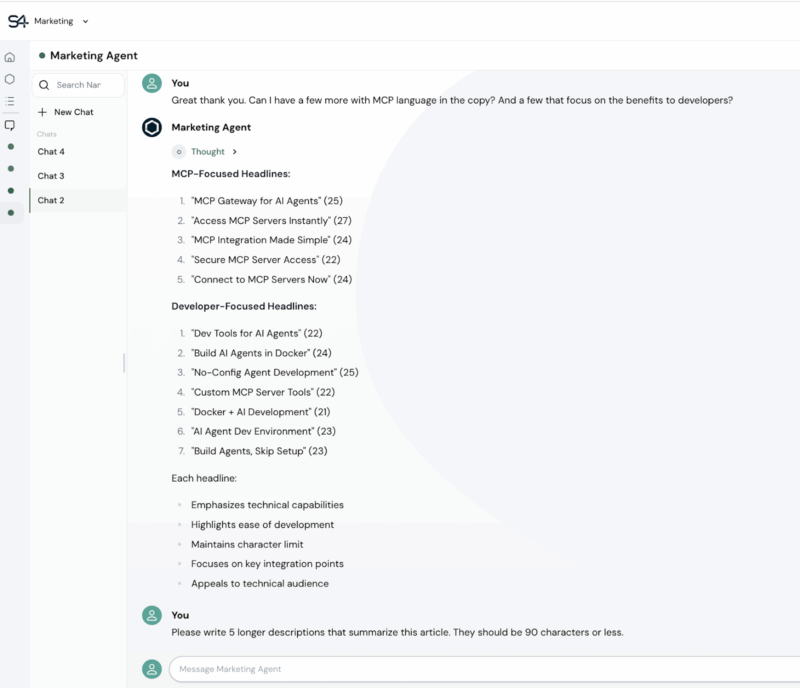
SEO & blog content that product teams love
Product management and product marketing teams are notoriously busy. We want most of their time spent on designing the product experience and working closely with customers. Using our marketing content agent to draft outlines and posts helps bridge the gap between marketing and product teams, and leverage the product teams’ expertise effectively.
Our marketing agent understands technical concepts and messaging, and is able to effectively translate them into posts that technical founders and product marketers can review and edit quickly. What makes this possible is the underlying reasoning engine that powers our agent—it doesn’t just generate content, it thinks through the strategic context, audience needs, and messaging hierarchy before crafting each piece. Through continuous tuning with our brand guidelines, messaging frameworks, and successful content examples, the reasoning engine has developed an understanding of what makes content effective for our specific audience and business goals.
It means we’re able to produce much more content and faster too. More importantly, the quality has dramatically improved because the reasoning engine maintains context across our entire content strategy—understanding how each piece fits into our broader narrative, ensuring consistency with our brand voice, and adapting tone appropriately for different content types and audience segments.
At Sema4.ai, we input SEO blog and learning center article guides right into our agent. The agent comes up with a draft outline, headlines, sub-heads, and the copy. The reasoning engine analyzes the strategic intent behind each content brief, considers our competitive positioning, and structures information in ways that align with both SEO requirements and our messaging priorities. This contextual understanding means the first draft isn’t just faster—it’s strategically sound and requires fewer fundamental revisions.
Most of our time is now spent on editing, adding images and diagrams, and reviewing for accuracy. So, instead of a week or longer to write a new article or blog post from scratch, then review, edit, and post live to the site, it now takes us two to three days. The reasoning engine’s ability to maintain context and learn from our feedback has transformed our editing process from major structural rewrites to fine-tuning and enhancement—the strategic foundation is already solid. I used our agent to come up with an outline and headlines for this post!
Our marketing command center: Sema4.ai’s Work Room experience
We have a dedicated workspace for marketing, and so do teams like sales, engineering, and customer success. Work Room is where we go to collaborate and work with our agents. I only see and use the agents assigned to me. It’s easy to manage and assign access rights and privileges. Control Room enables IT and AI operations teams to centrally secure and manage agents across multiple teams and divisions, and publish agents only to assigned workspaces.
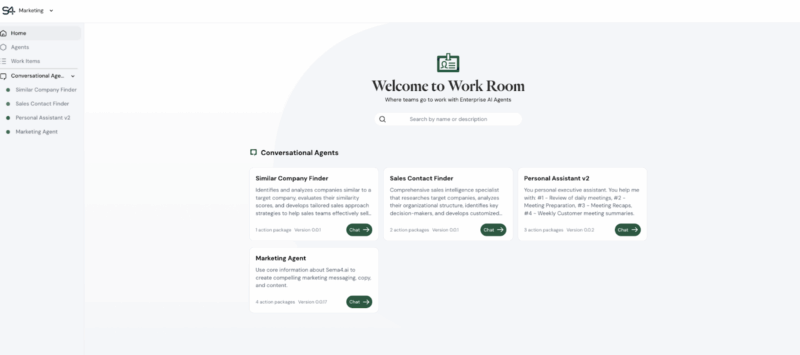
The bigger picture: what we’ve learned
Beyond time savings and productivity gains, the marketing agent has changed our content origination and creative processes. And it turns the folks that execute into more self-sufficient content creators. We have more confidence and independence. And we are all learning at a rapid pace. Learning and curiosity are embedded into our culture.
When you are improving productivity and have a team of people that are continuously learning, the company benefits. Work will get automated, but design, systems, and critical thinking skills are more important than ever in the AI agent economy. Over time, the use of agents to transform our business model will meaningfully increase ARR per employee, and that is a metric the CMO and CEO can take to the board and highlight in earnings.
Our co-founder and SVP of product management, Paul Codding, created the original marketing agent. Most marketers on our small team are now participating in new agent development processes!
The future of marketing with AI agents
Now that we’ve had such a positive experience using the marketing agent and we’ve discovered the productivity it helps us drive, we’re coming up with many other ways to use agents in our day to day operations. What’s next? I am helping keep our marketing runbook updated, and we are collaborating as a GTM team (marketing, SDR, revenue ops, sales engineering) to build a new multi-agent prospecting process that will drive better sales productivity. This would involve a manager agent and integrations with 6Sense, LinkedIn, and HubSpot. The agents would make campaign recommendations, do account research, database acquisition, write personalized email copy, send email and log activities in HubSpot, and help prepare reps for meetings. One of the other new use cases we’re beginning to work on is a predictive data analysis agent to support SEO traffic modeling and content forecasting.
The advice I’d give is to start with a problem you have that an agent can help solve. What makes a good use case? If your CMO can bring it into a board meeting, or your CEO can discuss it in an earnings call, it’s likely a problem worth automating with an agent.
Here are criteria to consider as you are prioritizing agentic use cases:
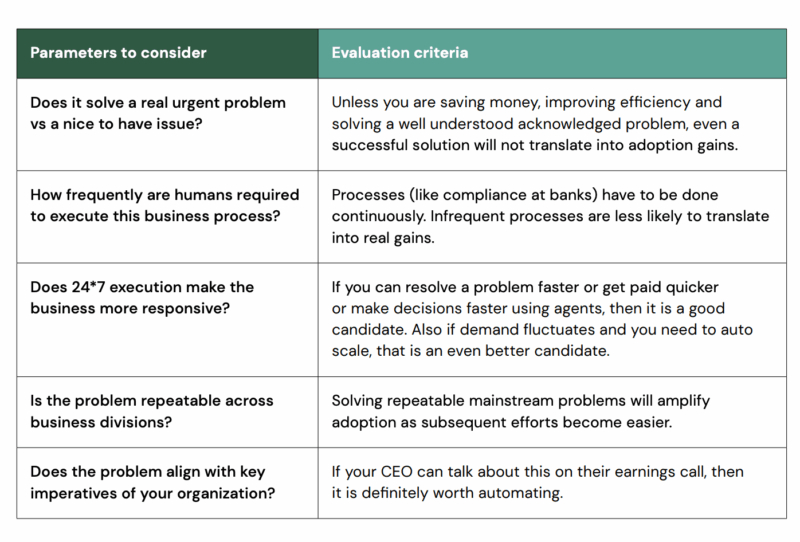
Outline your goals, the outcomes you wish to achieve, the work you want the agent to do (document how the work is currently done, how it’s currently measured, and how you want it to evolve), detail the guardrails for the agent, the data sources you need it to access, and the actions you want it to take in your applications. These are the raw ingredients of a well-designed runbook! Great marketers and UX designers know that beautiful, functional design can only be as good as the inputs and the creative brief we start with. So, do the homework of crafting your runbook!
You can also listen to the Tomorrow’s Best Practices Today podcast I recorded with Leadtail. I sat down to chat with Clark Newby, who first hired me into Silicon Valley. We talk about runbooks, my experience with our marketing agent, Sema4.ai Work Room, and marketing agent use cases. It’s a great resource for marketers interested in getting started with AI agents, and considering startup life.
From cautiously optimistic to enthusiastic advocate
I never imagined I’d be the first marketer in a Series A startup. I’ve always loved building – architecting demand engines and digital experiences have been my jam for years. The opportunity to strategically contribute to building a new AI agent platform in a game changing market is one of a kind. I don’t just get to market it, I get to help dream up and build agents that will make me and my team more successful. We are transforming our company’s own business operating model. You can be a citizen agent builder too, check out Sema4.ai to learn more!


